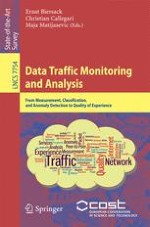2013 | Book
Data Traffic Monitoring and Analysis
From Measurement, Classification, and Anomaly Detection to Quality of Experience
Editors: Ernst Biersack, Christian Callegari, Maja Matijasevic
Publisher: Springer Berlin Heidelberg
Book Series : Lecture Notes in Computer Science
